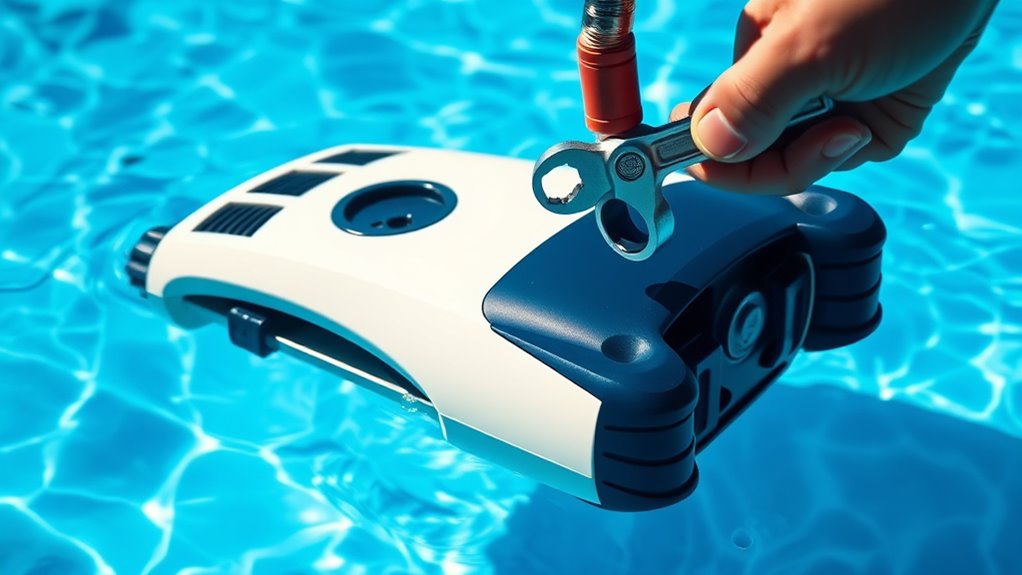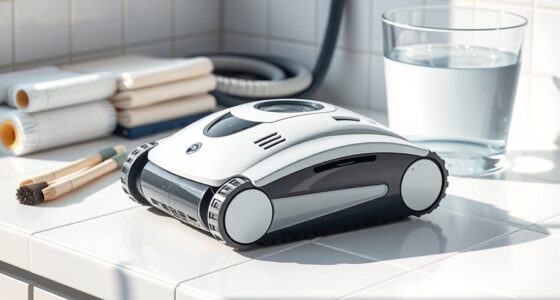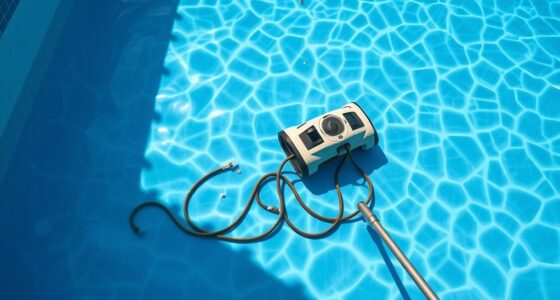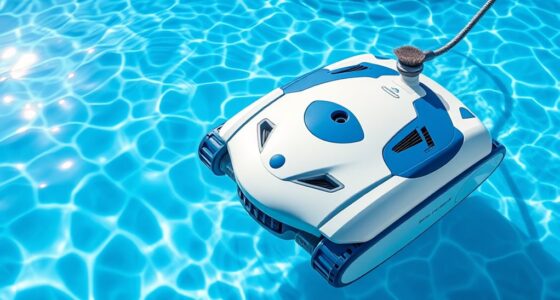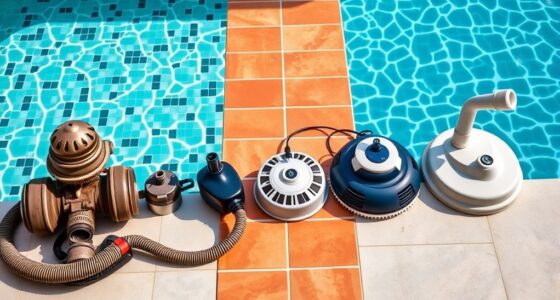If your automatic pool cleaner isn’t working well, start by checking the power supply to guarantee it’s plugged into a working outlet and all connections are secure. Inspect brushes and tracks for debris or wear, and clean or replace them if needed. Verify water levels, debris baskets, and skimmer valves are clear, and check the motor and drive system for any malfunctions. Proper navigation depends on clean sensors and aligned parts. Keep an eye out for worn components—you’ll find tips to troubleshoot further if you continue exploring.
Key Takeaways
- Check power supply, connections, and water level to ensure proper operation and prevent suction or electrical issues.
- Inspect brushes, tracks, and debris baskets regularly for wear, clogs, and obstructions to maintain cleaning efficiency.
- Verify skimmer, intake valves, and sensors are clear and functioning correctly for complete water flow and navigation.
- Examine the motor, drive belt, and gear assembly for wear, damage, or unusual noises, replacing parts as needed.
- Perform routine maintenance and troubleshooting to keep components in good condition and prevent future malfunctions.
Checking the Power Supply and Connections
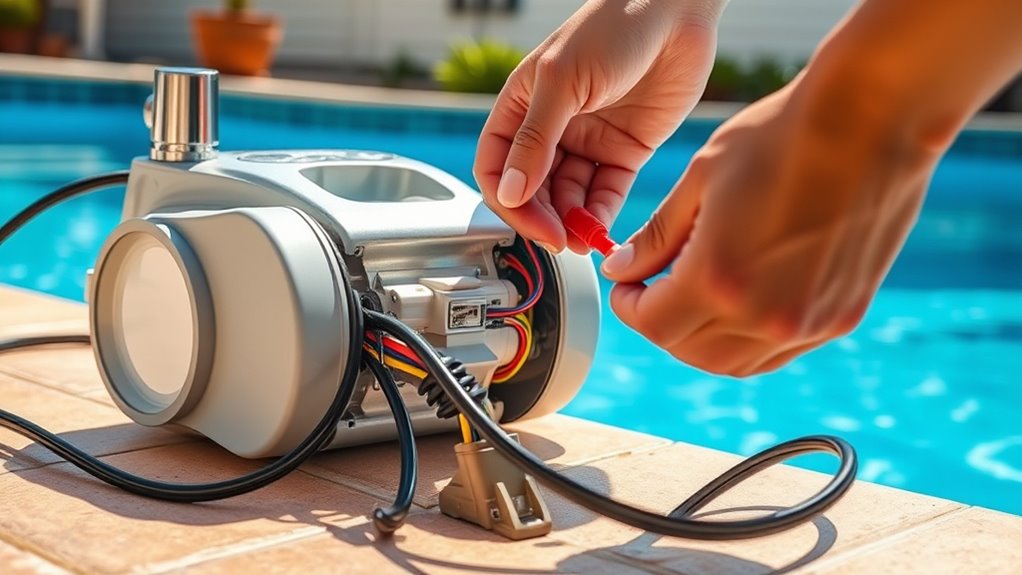
Before troubleshooting your automatic pool cleaner, you should start by checking the power supply and connections. Power surges can disrupt the unit’s operation, so verify the power outlet isn’t experiencing fluctuations. If your cleaner runs on batteries, check for battery issues first—make sure they’re fully charged and properly connected. Sometimes, a simple reset or replacement of batteries resolves the problem. Inspect the power cord and plug for damage or loose connections. Ensure the cord is securely plugged into a functioning outlet. If the cleaner isn’t receiving consistent power, it may stop working unexpectedly. Addressing these basic electrical issues often fixes the problem, saving you time and preventing further damage. Additionally, verifying the filtration system can help identify if debris buildup is affecting performance. Proper maintenance of the power system components can also prevent electrical failures. Regularly checking the electrical connections ensures stable operation and can extend the lifespan of your cleaner. To prevent future issues, consider inspecting the circuit breakers and ensuring they are functioning properly. Properly functioning electrical components are essential for the reliable operation of your pool cleaner. Once confirmed, you can move on to inspecting other components.
Inspecting and Cleaning the Brushes and Tracks
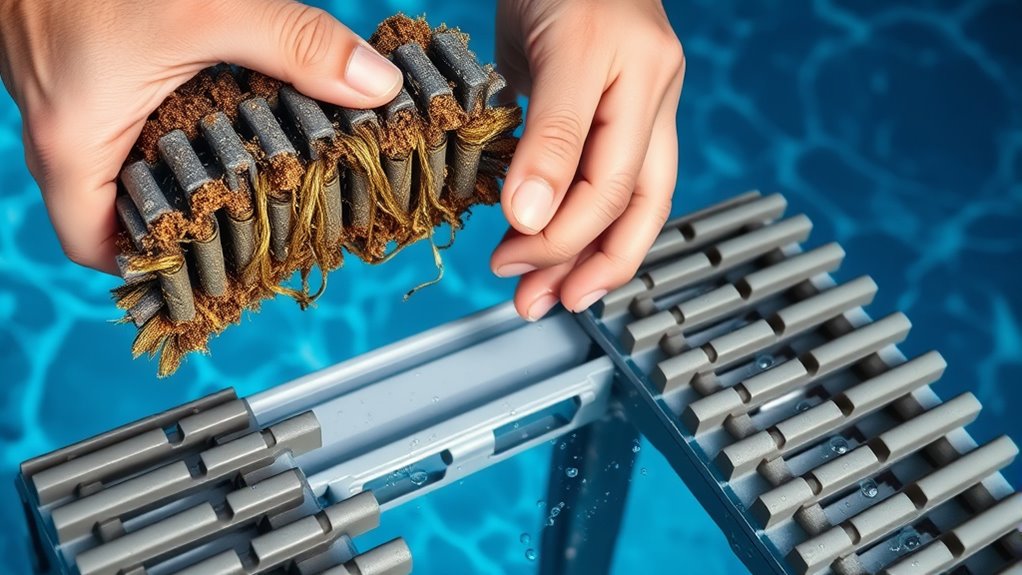
To keep your automatic pool cleaner operating efficiently, you need to regularly inspect and clean its brushes and tracks. Start by checking the brushes for wear or debris, as brush inspection helps prevent poor cleaning performance. If the brushes are worn or clogged, replace or clean them promptly. Track maintenance involves removing dirt, algae, or obstructions that can hinder movement. Regular cleaning ensures smooth operation and prolongs the cleaner’s lifespan. Use the table below to guide your upkeep:
| Step | Action | Frequency |
|---|---|---|
| Brush inspection | Check for wear or debris | Weekly |
| Track maintenance | Remove dirt and obstructions | Weekly |
| Brush cleaning | Rinse with water | After heavy use |
| Track cleaning | Wipe tracks with soft cloth | Monthly |
Consistent care keeps your cleaner running at peak performance. Additionally, inspecting pool equipment regularly can help identify issues before they affect your pool cleaner’s operation. Performing routine maintenance tasks on components such as motors and filters can also prevent unexpected breakdowns and maintain overall efficiency. Regularly checking appliance components can help spot potential problems early. Incorporating preventive measures into your schedule can further enhance the longevity of your pool cleaning system. Proper maintenance of automatic pool cleaners is essential for optimal functionality and cost savings.
Examining the Skimmer and Intake Valves

Start by checking if the skimmer and intake valves are functioning properly. Look for any obstructions or debris that could block water flow. Clearing these issues can often restore your cleaner’s performance quickly. Additionally, inspecting the valve operation ensures that water is being properly directed through the system. Proper system maintenance also helps prevent issues caused by digital literacy gaps among users. Regularly cleaning and inspecting the valves can help maintain optimal water flow, which is essential for effective pool cleaning.
Inspect Valve Operation
Have you checked whether your skimmer and intake valves are functioning properly? Valve operation directly impacts your pool cleaner’s efficiency. Start by inspecting the valve alignment to ensure they’re fully open and correctly positioned. Look for signs of a valve leak, such as unexpected water loss or drips around the fittings. Misaligned valves can restrict flow, reducing suction power, while leaks can cause pressure drops, hindering cleaning performance. Additionally, proper valve maintenance is essential to prevent debris buildup and ensure smooth operation. Regular checks can help identify issues early and maintain optimal pool circulation.
Clear Obstructions and Debris
Obstructions and debris can substantially impact your pool cleaner’s performance by blocking the skimmer and intake valves. When debris clogs these areas, your cleaner struggles to move efficiently, leaving dirt behind. Regularly inspect and clear out leaves, twigs, or algae buildup during seasonal maintenance to keep everything flowing smoothly. Also, confirm your pool’s chemical balance is correct, as imbalanced water can cause debris to cling to surfaces and clog valves. When cleaning, remove any obstructions carefully and test the operation afterward. Maintaining proper pool chemistry and performing routine checks help prevent clogs and prolong your cleaner’s lifespan. Proper water chemistry supports overall pool health and helps keep debris from sticking to surfaces, reducing the likelihood of clogs. Keeping the skimmer and intake valves clear ensures peak performance and a cleaner, healthier pool.
Assessing the Pool’s Water Level and Debris Baskets

Ensuring your pool’s water level is correct is essential for your automatic cleaner to operate effectively. If the water is too low, the cleaner may lose suction or get stuck; too high, and it might not reach all areas. Check the water level regularly, especially after heavy use or rain, and adjust as needed. Additionally, inspect the debris baskets to ensure they’re not full, which can hinder debris collection and reduce cleaning efficiency. Clean the baskets frequently to prevent buildup. Proper water chemistry also plays a role—imbalances can affect the pool lining and overall cleaner performance. Maintaining the right water chemistry is crucial, as it can also impact the longevity of your pool liner and equipment. Regularly monitoring and maintaining these aspects helps keep your automatic cleaner running smoothly and extends its lifespan. Being aware of pool water levels can help prevent issues with your cleaner and ensure optimal performance over time. Incorporating proper maintenance routines can significantly enhance the overall efficiency and lifespan of your automatic pool cleaner.
Troubleshooting the Cleaner’s Motor and Drive System

If your cleaner isn’t moving properly, the motor or drive system could be be the problem. Start by checking for any motor malfunctions or unusual noises, and verify the drive belt is intact. Troubleshooting these components can quickly get your cleaner back in action. Additionally, inspecting for suspension and handling issues can help identify if upgrades or repairs are needed to restore optimal movement. Regular maintenance of the drive system components can also prevent future malfunctions and ensure smooth operation, especially considering the importance of proper fabric decorating markers performance for achieving a flawless finish.
Motor Malfunctions and Checks
When your automatic pool cleaner isn’t functioning properly, motor malfunctions are often the culprit. Start by checking the motor for signs of wear or damage, such as strange noises or overheating. Verify the pool filter isn’t clogged, as a dirty filter can strain the motor and reduce performance. Also, confirm that the chemical balance in your pool is correct; improper levels can cause corrosion, affecting the motor’s components.
- Inspect the motor brushes and wiring for corrosion or loose connections
- Clean or replace the pool filter if dirty or clogged
- Test the motor by running it separately to listen for irregular sounds or failure
Drive System Troubleshooting
A malfunction in your pool cleaner’s drive system can prevent it from moving properly or steering your pool effectively. First, check the drive belt for signs of wear, cracks, or slipping, as a damaged belt can hinder movement. If the belt looks fine, inspect the gear assembly for debris, misalignment, or damage. A jammed or broken gear can stop the drive system from functioning smoothly. Ensure the drive belt is properly seated and tensioned; loose belts won’t transmit power efficiently. Also, examine the gear assembly for any broken or worn parts that might need replacing. Clearing debris and ensuring all components are correctly aligned can restore proper operation. Regular inspection of these parts helps prevent drive system failures and keeps your cleaner moving seamlessly.
Ensuring Proper Navigation and Coverage

Proper navigation and coverage are essential for your automatic pool cleaner to effectively tidy the entire pool surface. You want to make certain it follows efficient paths, minimizing missed spots. Check that the cleaner’s navigation algorithms are functioning correctly, as they determine movement patterns. Proper coverage optimization helps prevent over-cleaning in one area and neglecting others.
Ensure your pool cleaner covers every area efficiently by maintaining proper navigation and sensor checks.
- Verify the cleaner’s sensors and wheels to maintain accurate navigation.
- Clean any debris or obstructions that may hinder movement.
- Program or reset the cleaner’s navigation settings if needed.
Replacing Worn or Damaged Parts
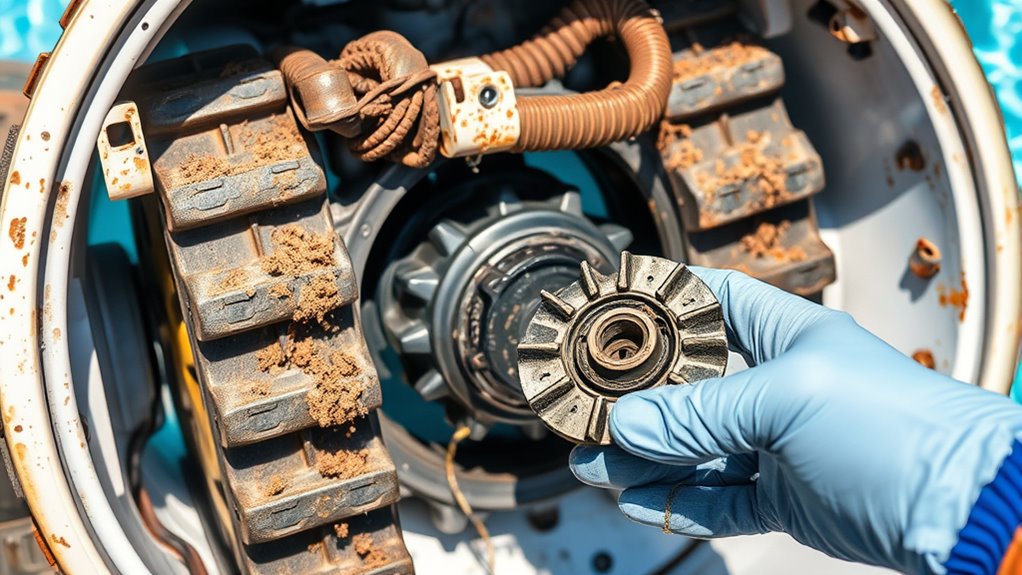
Worn or damaged parts can considerably reduce your automatic pool cleaner’s effectiveness, so inspecting and replacing them is essential for peak performance. Start by checking the filter—if it’s clogged or torn, perform a filter replacement to ensure proper suction and debris removal. Damaged or cracked hoses also hinder cleaning efficiency, so hose repairs or replacements are necessary to maintain proper water flow. Look for signs of wear, such as leaks or splits, and swap out damaged hoses promptly. Regularly inspecting these parts helps prevent bigger issues and extends your cleaner’s lifespan. Keeping parts in good condition ensures your cleaner operates smoothly, covering your pool thoroughly and saving you time and effort. Always use manufacturer-approved replacements for maximum results.
Frequently Asked Questions
How Often Should I Perform Routine Maintenance on My Automatic Pool Cleaner?
You should follow a regular maintenance schedule to keep your automatic pool cleaner in top shape. Typically, inspect your cleaner weekly, checking for debris, wear, and tear. Clean the filter and brushes as part of your routine, ideally every two weeks, and perform a thorough inspection monthly. These inspection tips help identify issues early, ensuring peak performance and longevity. Consistent maintenance keeps your cleaner running smoothly and prevents costly repairs.
What Are Signs That My Pool Cleaner’s Tracks Need Replacement?
If you notice your pool cleaner’s tracks slipping or not gripping surfaces properly, it’s a sign of track wear. Over time, tracks can become cracked, stretched, or brittle, reducing their effectiveness. When these issues occur, it’s time for track replacement. Regularly inspect your cleaner’s tracks for signs of damage or excessive wear, and replace them promptly to guarantee peak performance and avoid further damage to your device.
Can Debris in the Pool Affect the Cleaner’S Performance?
Imagine your pool cleaner as a diligent worker; debris buildup is like a heavy backpack, slowing it down. When debris clogs the filter, it’s like choking a essential artery, reducing performance. Yes, debris in the pool can hinder your cleaner’s efficiency, causing it to miss spots or stall. Regularly clear debris and check the filter to keep your cleaner running smoothly, much like giving that worker a lighter load.
How Do Temperature Changes Impact the Cleaner’S Operation?
You might notice that water temperature affects your cleaner’s efficiency. Cooler water can make the cleaner’s components, like motors and brushes, work harder or slow down, reducing cleaning performance. Warmer water helps the cleaner operate smoothly and efficiently. So, if you see your cleaner struggling, check the water temperature. Maintaining ideal water temperature ensures your automatic pool cleaner runs effectively, keeping your pool clean and clear.
Is It Normal for the Cleaner to Make Noise During Operation?
Ever notice your automatic pool cleaner making a bit more noise than usual? Noisy operation can sometimes be part of its charm, but unusual sounds might signal a problem. It’s common for cleaners to produce some noise during normal operation, but if the sounds become loud or irregular, it’s worth inspecting for obstructions or loose parts. Addressing these issues ensures smooth, quiet cleaning and prolongs your device’s lifespan.
Conclusion
By following these troubleshooting steps, you can keep your automatic pool cleaner running smoothly all season long. Regular checks and maintenance prevent minor issues from turning into big problems, saving you time and frustration. Remember, a well-maintained cleaner means a cleaner pool with less effort on your part. So next time your cleaner acts up, ask yourself: isn’t it worth a little effort to enjoy crystal-clear water effortlessly?
